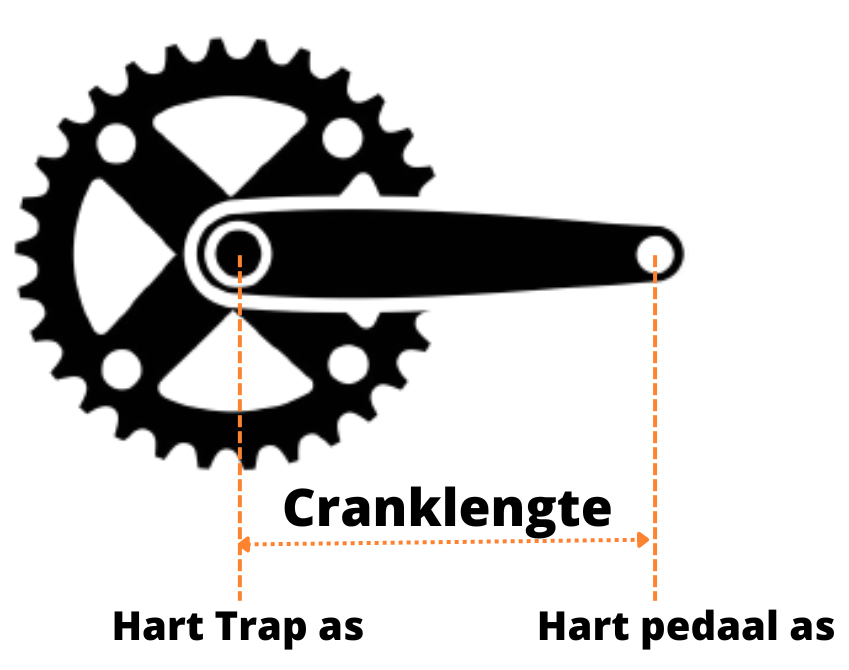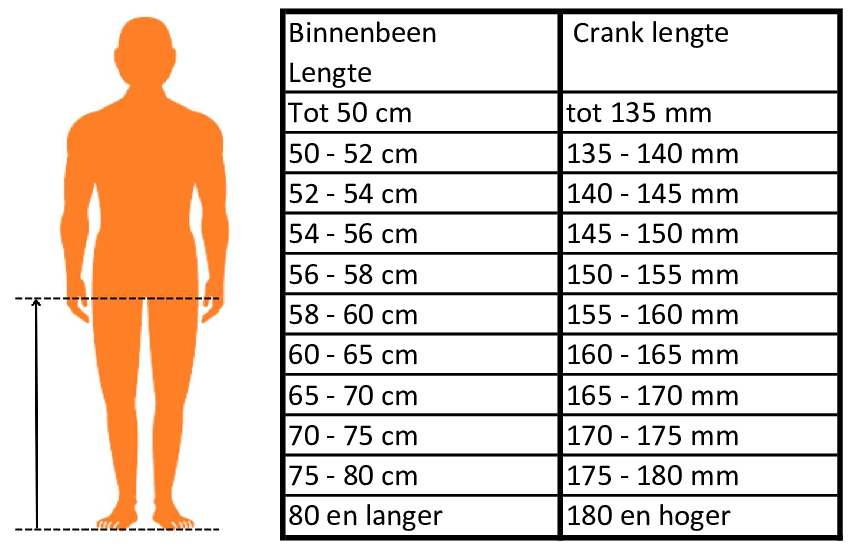Purchasing a bike for Race BMX can be quite confusing if you have little understanding of it.
Below we try to explain as best we can what to look for and inform you.
If you can't figure it out or have any questions, don't hesitate to contact us.
Determining BMX Size
BMX bikes all look small at first glance, but these bikes come in a variety of sizes.
Which size you need depends on the rider's height.
The height of a rider is linked to a frame size. The following frame sizes are available (from small to large): Micro, Mini, Junior, Expert, Expert XL, Pro L through 4XL and Cruiser. All bike sizes are 20 inches except the Cruiser, which is 24 inches.
 All numbers are a guideline. They may vary from person to person.
All numbers are a guideline. They may vary from person to person.
Determining crank length
The length of the cranks depends on the inseam. You measure this by standing against a wall without shoes and then measuring the length from the crotch to the ground.

In the table below you will find a guideline for crank lengths.
(Note that this is measured "center to center," that is, from the center of the bottom bracket (Bottom Bracket) to the center of the pedal axle.
 All numbers are a guideline. They may vary from person to person.
All numbers are a guideline. They may vary from person to person.
Determining resistance (safe sizes)
Determining the proper gear ratio can be quite a challenge, the optimal gear ratio allows for a good start, good acceleration on the track and the ability to maintain speed. You don't want to pedal too light, you'll have a fast start but struggle to get up to speed and stay there because you have to do too many revolutions, but pedaling too heavy is the exact opposite.
To determine the correct gear ratio, the first thing to do is to determine the pedal rotation. The pedal rotation is calculated by measuring the distance the bike travels when the pedals turn a full circle. The table below provides a guideline for the pedal rotation.
 All numbers are a guideline. They may vary from person to person.
All numbers are a guideline. They may vary from person to person.
Determining gear ratio
What the best sprocket ratio is, by this we mean the ratio between the front sprocket and rear sprocket for a racing BMX bike, is different for each BMX rider. Each cyclocross rider will have to figure out for themselves what works for them and what doesn't.
There are plenty of options as you can see in the tables below. The horizontal numbers from 34 to 44 are the number of teeth of the front sprocket and the vertical numbers from 13 to 21 indicate the teeth of the rear sprocket. In the table you can then see what distance (in centimeters is covered in 1 revolution of the pedals).
The greater the distance in per revolution the heavier the pedaling and vice versa. Light pedaling means shorter distance per revolution. Useful at the Start to pedal away quickly from standstill or to do a sprint halfway down the course. But when you get to a long straight, it is not useful to ride with a light gear because you will be overtaken by someone with a heavier gear. This means you have to choose the combination that gives you the best of both between sprinting (light pedaling) and maintaining pace/acceleration (heavy pedaling).
If you choose too light a ratio, you may go first at the start, but you won't keep up with the rest of the track because too many revolutions are required. If you choose too heavy a ratio, you may be able to keep up for long distances just fine, but at the start you will see your opponent cycling far ahead.
So what combination works best for you you will have to go find out. See what is currently on your bike and look it up in the table. If you feel you are pedaling too hard, choose a lighter combination and if you are pedaling too hard choose a larger gear.
Using this table, you can clearly see how much difference there is if you try different sprockets front or rear.
Remember: it's only about centimeters, but you will definitely notice it if you go only 1 tooth bigger or smaller. So don't change too much!




 All numbers are a guideline. They may vary from person to person.
All numbers are a guideline. They may vary from person to person.
 All numbers are a guideline. They may vary from person to person.
All numbers are a guideline. They may vary from person to person.






